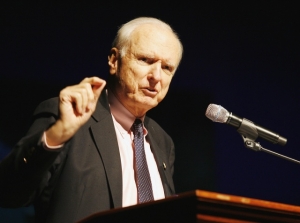Forum speaker says downtowns should be solid
By Anessa Myers
Published in News on January 16, 2009 1:46 PM

News-Argus/GREG SOUSA
William Hudnut III, of the Urban Land Institute, speaks during the seventh Annual Speakers Forum at the Paramount Theatre in Goldsboro, N.C. on Thursday, Jan. 15, 2009. Hudnut is a former U.S. Representative and former four-term mayor of Indianapolis, who earned national recognition for revitalizing that city. He currently holds the Urban Land Foundation/ Joseph C. Canizaro Chair for Public Policy at the Urban Land Institute in Washington, D.C.

News-Argus/GREG SOUSA
William Hudnut III, of the Urban Land Institute, speaks during the seventh Annual Speakers Forum at the Paramount Theatre in Goldsboro, N.C. on Thursday, Jan. 15, 2009. Hudnut is a former U.S. Representative and former four-term mayor of Indianapolis, who earned national recognition for revitalizing that city. He currently holds the Urban Land Foundation/ Joseph C. Canizaro Chair for Public Policy at the Urban Land Institute in Washington, D.C.
The speaker at the annual Speaker's Forum Thursday at the Paramount Theatre compared cities with cookies and doughnuts, saying Goldsboro residents should want their city to be a cookie -- solid all the way through -- and not a doughnut, with a hole in the middle.
William H. Hudnut III, a former mayor of Indianapolis, Ind., said every city has an area that serves as "the heartbeat" and he focused on downtowns and how to make them the most vibrant and functional parts of a city.
"The downtown in Indianapolis was hollowing out. The centrifugal forces were drawing people to the suburbs and so-called greener pastures. My job was to reinforce the centrifugal forces that brought the downtown back to life. ... You can't be a suburb of nothing."
That was just one piece of advice that he gave to the more than 50 people that attended the event.
He also had a laundry list of other suggestions on how to improve any city's downtown, the first of which was to "mind the store."
"You have got to deliver basic services well. If you don't do that, you're going to have problems," Hudnut said, relating a story about how important such basic services as garbage collection are.
Downtowns should be well maintained, safe, and well lit, and officials must "fix what's broken rather than build everything new," he said.
He also said that city leaders need an overall plan and need to stick to it. Residents have to be included in the planning if it is to be successful, he noted. Developing and implementing such plans take patience and determination, Hudnut said.
"You've got to have patience. Rome wasn't build in a day and neither is Goldsboro or Indianapolis," he said.
Hudnut also said that downtown areas should be made up of mixed uses and said that combining retail uses with residential and office uses is a great way to not only bring people together but to also bring life to the area during the day and night.
"You don't want to walk down the street and not see anybody," he said. "You want it to be a lively place."
And to accomplish that, there must be a mix of density and diversity of residential areas, too.
"But we want density with good design, not warehousing people in 20-story buildings," he said.
In short, he said, downtowns should strive for what he called "walkable urbanism" -- a well-designed, mixed use, higher density development where people could eat, hang out, shop and stay within one walkable area.
That urban environment attracts three types of people, Hudnut said, referring to them as "singles, mingles and jingles."
"Singles are your young professionals that have computers and will travel. Mingles are young, married or unmarried couples without children. And jingles are happy empty nesters that are tired of suburbs, tired of the long commute to work, tired of taking care of a four or five bedroom house," he said.
For all of those groups, downtowns represent a value.
"They save money on transportation. It's a more economical way of life. You are walking more. You are spending less. And it reduces infrastructure costs," Hudnut said.
Downtowns should also have activity, something that enhances public space.
"You do that now with your Center Street Jams," he said, but he added that they also should maintain their historical character.
"Preserve the old, at least some of it," he said. "There needs to be a good balance of historical with newer buildings that both fit together. You have history. ... And you have the possibility for attracting historic tourism. People will want to come tour the old homes in Goldsboro."
His last few suggestions were for city officials to provide transportation choices for its residents through projects like the ongoing Union Station renovations, build on the culture and the arts of the community through projects like the rebuilding of the Paramount Theatre, take positive action in creating a path to downtown improvement through regulations and development and to "think small."
"There is no such thing as a magic wand or a silver bullet. It's the small things that make the difference. Urban fabric is stitched together with lots of little things -- it could be a clock in a mall or a canal in a city," Hudnut said.
The speaker said he had high hopes for Goldsboro.
"I think you have a magnificent opportunity to rebuild your downtown," he said. "And you are well on your way."
